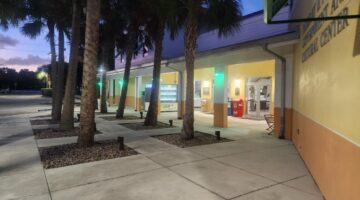WPA murals are history via art;
they’ll stay at new City Hall
The recent report that the entire interior of the old Glynn Archer School was to be or perhaps had been demolished in its conversion into the next Key West City Hall elicited a frisson of fear. What about those wonderful WPA murals in the auditorium?
Not to worry.
The 12-foot, 4-inch by 8-foot, 3-inch murals were initially gently dry-cleaned with cosmetic sponges to remove surface dirt on the front and, after removal, on the back by professionals last August, reported Viviana Dominguez, who, according to her published credits, is “an art conservator certified by the American Institute for Conservation ( AIC). She has more than 20 years of experience in the field of preserving and conserving of art collections and national monuments through both hands-on projects and education.”
Konk Life spoke with Dominguez in the fairly small workrooms on the second floor of the Key West Art and Historical Society last week. After the removal of the canvas murals, they were rolled on huge tubes, about three-feet in diameter, and suspended horizontally about six feet off the ground from the ceiling of the Custom House work space.
The actual work of conservation began about two weeks ago, she said. Unrolled from the tubes, the murals were stretched on new stretcher bars, augmented by additional canvas called “strip lining” on edges where necessary. Then began the meticulous task of conserving the art work: Close examination to record visible damage, to discern where repairs were previously made and to set to work filling scratches and retouching color – a painstaking process of retouch and varnish, retouch and varnish, again and again, “blending the colors to match the originals,” she explained in illuminating detail.
Of particular interest, Dominguez noted the difference between conservation and restoration. The murals are bona fide, historically-priceless cultural artifacts, reflective of the 1930s “Works Progress Administration (renamed in 1939 as the Work Projects Administration), the largest and most ambitious New Deal agency” created by the Franklin Delano Roosevelt’s administration to put people – in this case artists – back to work during the Great Depression.
Conservation involves “taking into consideration all the steps that are necessary to preserve the piece,” including meticulous documentation of every step, she said. “We use materials that are reversible, which means they are very stable but could be removed over time” if it were necessary for historical purposes. “Conservation involves not only the aesthetic part but the historical component of the piece.”
Restoration, on the other hand, “could mean redoing of a piece completely or a repair – not documented – sometimes very invasive. We’re not looking into the future (or historical value) of a restored piece.”
PHOTO/
Assistant Stephanie and conservator Viviana Dominguez at work.
[livemarket market_name="KONK Life LiveMarket" limit=3 category=“” show_signup=0 show_more=0]



No Comment